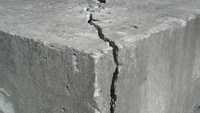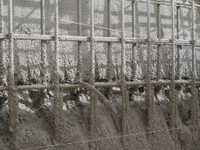Shrinkage Reduced Concrete
Concrete increases in volume after setting and during hardening, inducing tension in the reinforcement, and compression in the concrete. Shrinkage-compensating concrete is a high-performance concrete that compensates for drying shrinkage, minimizing cracks caused by drying shrinkage stresses exceeding the drying shrinkage of concrete. The initial expansion of low shrinkage concrete is generally expected to offset the drying shrinkage. Stresses occurring from the expansion are less damaging than stresses occurring from drying shrinkage as generally, the expansion occurs when the stiffness of concrete and modulus of elasticity are not fully developed. Concrete drying shrinkage typically ranges from 0.03% to 0.06% and is determined using ASTM C157M.
The production of low shrinkage concrete requires a controlled expansive chemical reaction. Ettringite is a mineral crystal that forms quickly when Portland cement and water are mixed. The crystal structure of ettringite contributes very little to the strength but takes up a considerably large amount of volume in concrete. Expansive cement makes use of these properties of ettringite to cause the primary expansion after the concrete sets. The initial expansion of ettringite if properly restrained offsets strain caused by drying shrinkage.
Materials should be carefully ascertained. ASTM C806 measures the expansive potential of cement materials and component systems. Expansive cement type K, Type M or Type S are used, or a combination of Portland cement and expansive component, which when mixed with water forms a paste that after setting, increases in volume to a significantly greater degree than Portland cement paste. Aggregates with a higher modulus of elasticity or larger aggregate size contribute to reducing drying shrinkage as opposed to aggregates with significant chloride amounts, which increase shrinkage.
Mix proportions have a significant impact on drying shrinkage. The water requirement for low-shrinkage concrete is greater than for traditional concrete mixes for the same consistency. Lower water-cement ratio concrete, achieved through Calcium Chloride should not be used in shrinkage compensating concrete.
Contractors should ensure proper placing, finishing, and curing. Delays in placement should be avoided to avoid slump loss. The curing system should compensate for subsequent drying shrinkage. The finishing characteristics of low shrinkage concrete are typically better than with normal concrete mixes as they exhibit little or no bleeding even if a high slump loss occurs. Concrete should be protected from temperature extremes and be water cured at moderate temperatures. Proper curing is necessary to avoid insufficient expansion, resulting from a poor curing system, causing drying shrinkage.
Holderchem provides technical assistance pertaining to concrete mix designs and offers products required for the production of shrinkage reduced concrete including the following:
- Shrinkage reducing admixture to greatly reduce shrinkage in conformity with ASTM C494 Type S. It is used in topping slabs to minimize cracking and in marine environments and for watertight concrete in reservoirs, sewage treatment plants, and dams.
- High-range water-reducing, medium-range water-reducing, and water-reducing admixtures, which reduce water quantity while maintaining workability. They are needed to place and compact concrete. Reducing the water-cement ratio from 0.45 to 0.35 can result in a decrease in the drying shrinkage of concrete up to 50 %.
- Curing compounds, which enable concrete to achieve higher tensile capacity before drying out takes place.








